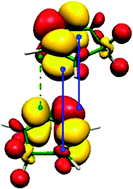Rationalization of Diels–Alder reactions through the use of the dual reactivity descriptor Δf(r)
Abstract
In this work, the dual descriptor of chemical reactivity, an electronic density-based index, is used to study both the regioselectivity and the stereoselectivity of Diels–Alder reactions. The descriptor has been designed to simultaneously delineate the nucleophilic and electrophilic sites within a molecule. Subsequent pairing between the nucleophilic and electrophilic regions of the reagents predicts the major adducts in all cases studied. Specifically, the descriptor predicts the generation of a ortho-regioisomer when a diene monosubstitued at position 1 by an Electron Donating Group (EDG)/ Electron Withdrawing Group (EWG), reacts with a dienophile monosubtituted by an EWG/EDG. Under the same conditions, if the diene is monosubstituted by either an EWG or an EDG at position 2, formation of the para-oriented adduct is predicted. This approach also provides insight into the stereoselectivity. For example, secondary interactions between the non-reactive regions of the reactants explain why the endo stereoisomer is preferred.

- This article is part of the themed collection: Highlighting Canadian research in PCCP

 Please wait while we load your content...
Please wait while we load your content...